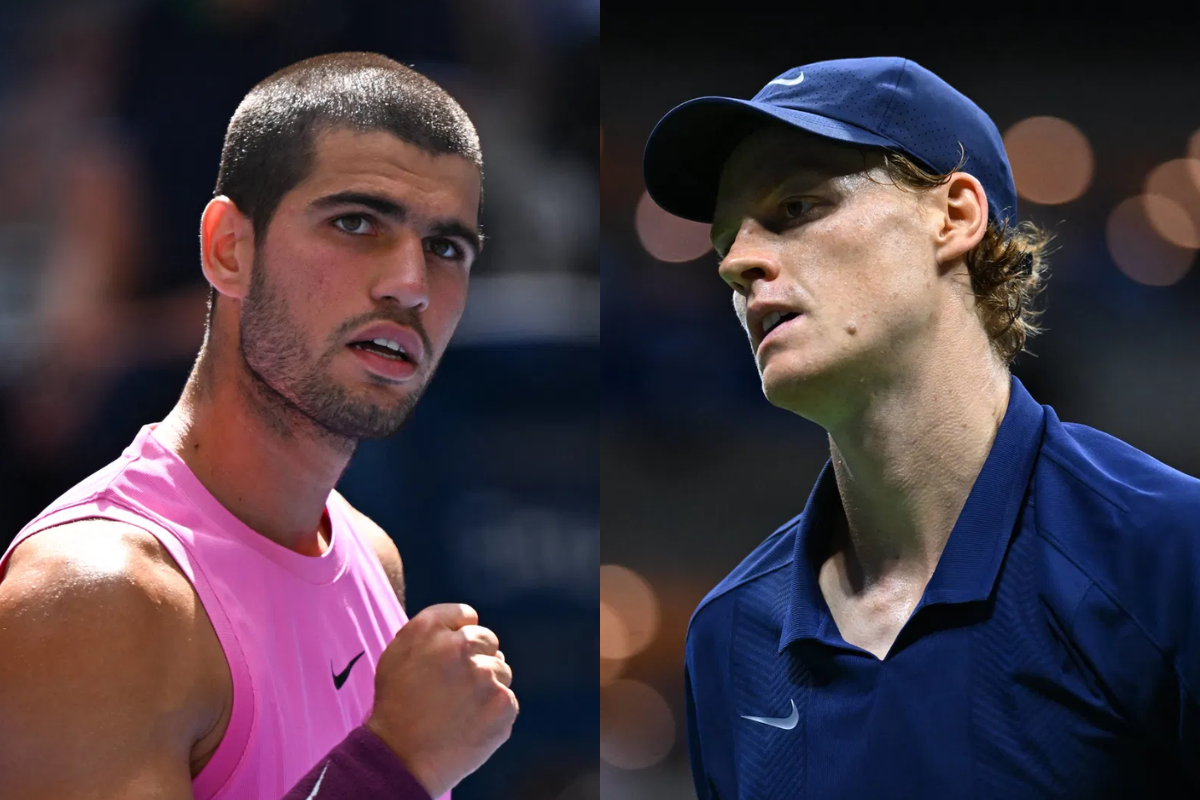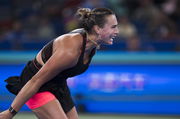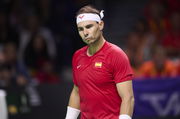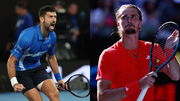
Imago
Credits: IMAGO

Imago
Credits: IMAGO
Three years ago, under the Arthur Ashe lights, Jannik Sinner and Carlos Alcaraz delivered a five-set epic that became an instant classic, with the Spaniard marching toward his first Grand Slam crown and foreshadowing the era to come. Fast forward to today, and history felt poetic: Alcaraz once again stood tall, striking the championship point to claim the US Open throne, his second hard-court major, and sealing his status as the emperor of the tennis world. Across the net, Sinner was left shattered, his dream slipping away under the weight of missed chances and costly lapses. And yes, there are reasons: deep, technical reasons for why this battle tilted so decisively in Carlos’s favor.
Watch What’s Trending Now!
Points win on the first serve: Jannik Sinner vs Carlos Alcaraz
When a Grand Slam battle unfolds, it’s never just about raw power; it’s the little things that decide destiny. First-serve points often become the heartbeat of the match, dictating momentum and crushing nerves. Today, Carlos Alcaraz meant business. He owned the crucial moments, winning 83% of his first-serve points compared to Sinner’s 69%, and that’s exactly where the match took its sharp turn.
ADVERTISEMENT
Consistency? Alcaraz doesn’t just talk about it, he lives it. “For me it’s great. It’s something that I’m working on, just the consistency in the matches, in the tournaments, in the year in general,” Alcaraz said. “Just not having ups and downs in the match. Just the level that I start the match [with], just wanted to keep that level really high during the whole match.”
Jannik Sinner’s double faults
Double faults told the story of this clash, and they told it loud. Jannik Sinner, usually ice-cold under pressure, sprayed 4 double faults across the match, handing away the momentum point by point. Carlos Alcaraz? Sharp as a blade, he didn’t give away a single one, a statement as bold as it was brutal.
ADVERTISEMENT

Imago
US Open – Quarter Final Jannik Sinner ITA during his quarter final round match at the 2025 US Open at Billie Jean National Tennis Center in New York City, NY, USA, on September 3, 2025. Photo by Corinne Dubreuil/ABACAPRESS.COM New York City United States PUBLICATIONxNOTxINxFRAxUK Copyright: xDubreuilxCorinne/ABACAx
That was the heartbeat of his victory, the moment the tide fully turned. The six-time major champion showed why his name now echoes through tennis history. The fewest sets he has ever dropped en route to a major title was four at Wimbledon 2023, and this run felt just as ruthless.
ADVERTISEMENT
For Carlos, the US Open tasted sweeter than ever. For Sinner, the heartbreak ran deep, a near-perfect run shattered on the very last step of the defense.
Top Stories
Aryna Sabalenka’s Battle of Sexes Participation Receives Criticism From Top Coach

WTA Player’s Misbehavior With Ball Kid Triggers Backlash From Former Tennis Pro

Novak Djokovic Makes a Bold Coaching Move As He Looks the Challenge Carlos Alcaraz & Jannik Sinner in 2026

Rafael Nadal Faces New Injury Blow Only a Year After His Emotional Tennis Exit

Novak Djokovic Labeled the Safer Bet for Slam Glory Than Alexander Zverev in a Bold Prediction

Receiving points
Carlos Alcaraz’s triumph felt like a redemption ballad, a statement win that washed away the sting of his heartbreaking Wimbledon final loss to the same Italian rival. This was about more than a trophy; it was about restoring his throne. Sinner, meanwhile, struggled to keep pace, losing crucial receiving points, 24 compared to Carlos’s 47, leaving him a step behind in the chase for the US Open crown.
ADVERTISEMENT
But the story didn’t stop there. Carlos not only owned the rallies but also dominated the pressure moments, converting more break points than Sinner and blasting 10 aces, leaving the Italian searching for answers. Every serve felt like a hammer, every break like a dagger.
The match
The opening game set the tone, and Carlos Alcaraz wasted no time in seizing control. His first break of serve came with a flurry of brilliance, two monstrous forehands that sent Jannik Sinner scrambling helplessly across the baseline.
ADVERTISEMENT
Then came a backhand half-volley scooped off his shoelaces, and another forehand winner struck at full stretch. There are always signs when Alcaraz is feeling his tennis, and his forehand firing early is one of the clearest. Add in his signature fake drop shot, the one that morphs into a disguised forehand slice, and it was obvious from the very first exchanges that he had brought his full arsenal to Arthur Ashe.
In the early stages of the second set, the message was loud and clear. Alcaraz had racked up 12 winners against just 6 unforced errors, delivering a masterclass in controlled aggression. This wasn’t just about trading blows; he was making a statement, refusing to give Sinner anything for free.
The Italian had no choice but to step inside the court and force the issue if he wanted to stay alive in the match. For a stretch in the second set, Sinner rose to the challenge and did exactly that, but the reprieve was short-lived. By the third set, Alcaraz had rediscovered his rhythm, and Sinner’s resistance began to crumble.
ADVERTISEMENT
This was not just another high-level final. Alcaraz entered the contest in devastating form, not having dropped a set all tournament, riding a run of 35 wins in 36 matches, and reaching eight finals during that blistering stretch.
The challenge for Sinner was monumental: could he find the level required to derail a player who had been boiling hot for months? He finally struck gold in the fourth game of the second set, stepping boldly into his backhand and refusing to be pushed behind the baseline by the height and weight of Alcaraz’s shots.
Yet the shot that defined this final was the forehand. Both men possess some of the most destructive forehands in tennis, but only one was firing when it mattered most. Sinner sprayed four forehand errors in the very first game, two of them unforced, handing over the early break that would haunt him through the rest of the set. He closed the set with five unforced errors on that wing and managed just two winners, never able to truly hurt Alcaraz.
ADVERTISEMENT
Alcaraz, in contrast, was painting forehand masterpieces. He hit eight forehand winners in the first set alone, dictating rallies with depth, mixing in drop shots, and pulling the trigger cross-court and down the line with fearless precision. His creativity was on full display with the fake drop shot, a move reminiscent of Roger Federer at his peak, and even Federer would have nodded in approval at the way Alcaraz was using it to dismantle his opponent.
Sinner’s usual weapon, his forehand, looked strangely underpowered. Even the running forehand he had revamped ahead of Wimbledon, failed to trouble Alcaraz this time. The Italian briefly flipped the script in the second set, unloading a vicious cross-court forehand to earn an early break, but by the start of the third, the shot betrayed him again. He missed a routine forehand wide to get broken immediately and repeated the error to gift the double break. By then, Alcaraz was back to lacing winners at will, reclaiming the momentum for good.
There were two decisive battlegrounds in this final: forehand and serve. Alcaraz ruled both. Sinner’s serve had looked shaky throughout the tournament; his semifinal against Félix Auger-Aliassime a lucky escape, helped by his opponent’s errors at crucial moments. Against Alcaraz, there would be no such mercy. The Spaniard punished every second serve and every dip in pace, turning Sinner’s biggest vulnerability into the weapon that sealed his fate. This wasn’t just a win for Alcaraz; it was a statement, the kind of victory that cements legacies and deepens rivalries.
ADVERTISEMENT
With the win, the Spaniard roared back to the summit of the ATP rankings, toppling his archrival from the throne. The question now burns bright: can he hold the No. 1 torch until the year ends?
ADVERTISEMENT
ADVERTISEMENT
ADVERTISEMENT

